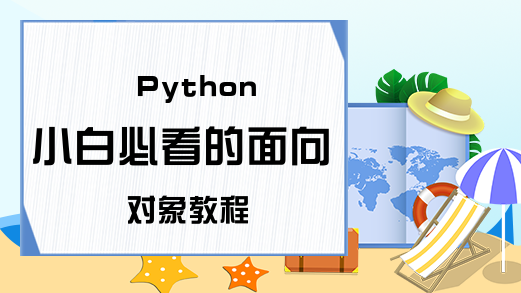Python小白必看的面向对象教程
【摘要】Python 是一门完全面向对象的语言。在 Python 中,一切都是对象。从我们开始使用 Python 时,我们就已经使用了 Python 中的对象和类

Python 是一门完全面向对象的语言。在 Python 中,一切都是对象。从我们开始使用 Python 时,我们就已经使用了 Python 中的对象和类。
Python 程序中的每一个元素都是类的一个实例,如数字、字符串、列表、字典这些元素,都是 Python 内置类对应的一个对象,甚至于使用 def 关键字定义的一个函数都对应一个 function类。
面向对象基础
Python 使用 class 关键字声明一个类。
一个典型的 Python 类主要包含以下成员:
构造函数 (constructor)
实例属性 (Instance Attributes)
类属性 (Class Attributes)
方法 (Class Attributes)
一个类也可以没有任何成员,如下面的 Car 类就没有任何成员:
class Car:
'''This is an empty Car Class'''
pass下面的类则包含了实例属性、类属性、构造函数、方法等成员:
class Car:
brand = 'BenChi'
def __init__(self):
self.price = 10000
self.chair = 7
def run(self):
print('Run 100km Per Hour....')构造函数
在 Python 中,构造函数是实例化一个类对象的时自动被调用的函数,类似于 Java 或 C# 中的构造函数。构造函数必须使用一个特定的名称 __init__ ,并且必须有一个固定的参数 self 。
Python 类中 几乎 每一个方法都要将 self 作为第一个参数,self 是调用该方法的对象的引用。其实,第一个参数的名字是任意的,并不一定要叫 self, self 只是一种约定。
注意,注意,注意: __init__ 方法并不是 Python 类构造函数,关于 Python 类的构造函数其实有很大争议,这里主要是为了介绍面向对象的概念。
下面的例子定义了一个构造函数:
class Car:
def __init__(self):
print('Call Constructor......')
car1 = Car()
car2 = Car()Python 中构造函数( init )的作用定义了类实例的属性,并对实例属性进行复制。
实例属性
实例属性是与类实例绑定的属性,其定义在构造函数( init )中。
下面的例子定义了两个实例属性:
class Car:
def __init__(self):
self.price = 100
self.chair = 7类属性
类属性不同于实例属性,类属性的值被所有实例对象共享。类属性在类级别定义而不是定义在__init__ 方法中。类属性的访问也不同于实例属性,类属性的访问是通过类名, 也可以通过实例访问。
下面例子定义了一个类属性
class Car:
brand = "benchi"
print(Car.brand)通过类名修改类属性
通过类名修改类属性,那么该类所有的实例对象对应的类属性都会被修改, 如下:
class Car:
brand = "benchi"
car1 = Car()
car2 = Car()
print('Before Change.............')
print(f'car1 brand is: {car1.brand}')
print(f'car2 brand is: {car2.brand}')
print('Change Class Attribute By [Class Name]')
Car.brand = 'Audi'
print('After Change.............')
print(f'car1 brand is: {car1.brand}')
print(f'car2 brand is: {car2.brand}')
输出:
Before Change.............
car1 brand is: benchi
car2 brand is: benchi
Change Class Attribute By [Class Name]
After Change.............
car1 brand is: Audi
car2 brand is: Audi类方法
在一个类中,可以定义尽可能多的类方法,一般情况下,类方法的第一个参数都是 self 。
下面的类就定义了一个类方法:
class Car:
brand = "benchi"
def run(self):
print('Run......')面向对象之封装
面向对象语言,如Java、C++等,使用 public 、 protected 、 private 等关键字来控制对类资源的访问。
类的 private 成员仅能在类内部进行访问,其他任何地方都不能访问,包括其子类。
类的 protected 成员可以在类内部和其子类中访问。
类的 public 成员可以在任何地方进行访问。
Python没有使用关键字机制来限制对类成员方法和类成员属性的访问,Python规定了一种约定,在类方法或者类成员前加 _ (下划线)或者 __ (双下划线)来模拟 private 或者 public 访问修饰其的功能。
面向对象之继承
在面向对象编程中,继承是达到代码重用目的的一种方式。在继承中,子类可以使用其父类的一部分代码。
继承的基本使用
下面先创建一个父类, 代码如下:
class Fish:
def __init__(self, first_name, last_name="Fish",
skeleton="bone", eyelids=False):
self.first_name = first_name
self.last_name = last_name
self.skeleton = skeleton
self.eyelids = eyelids
def swim(self):
print("The fish is swimming.")
def swim_backwards(self):
print("The fish can swim backwards.")接下来,创建一个没有任何方法和属性的子类,代码如下:
class Trout(Fish):
passPython类继承的语法是在定义类的时候,传入父类的名字作为参数
由于 Trout 类继承了 Fish 类, Trout 类就是 Fish 类的子类, Trout 类的对象就可以调用其父类的所有方法,代码如下:
terry = Trout("Terry")
print(terry.first_name + " " + terry.last_name)
print(terry.skeleton)
print(terry.eyelids)
terry.swim()
terry.swim_backwards()
输出:
Terry Fish
boneFalseThe fish is swimming.
The fish can swim backwards.接下来,再创建另一个子类,该子类有自己的方法:
class Clownfish(Fish):
def live_with_anemone(self):
print("The clownfish is coexisting with sea anemone.")创建 Clownfish 的一个对象,并调用其方法:
class Clownfish(Fish):
def live_with_anemone(self):
print("The clownfish is coexisting with sea anemone.")
casey = Clownfish("Casey")
print(casey.first_name + " " + casey.last_name)
casey.swim()
casey.live_with_anemone()
输出:
Casey Fish
The fish is swimming.
The clownfish is coexisting with sea anemone.从输出结果可以看出, Clownfish 的对象 casey 可以调用其父类的 swim() 方法和 __init__() 方法,同时可以调用它自身的 live_with_anemone() 方法。
就业培训申请领取


环球青藤
官方QQ群扫描上方二维码或点击一键加群,免费领取大礼包,加群暗号:青藤。 一键加群


刷题看课 APP下载
免费直播 一键购课
代报名等人工服务










